URUGUAY
Montevideo

Montevideo
Montevideo
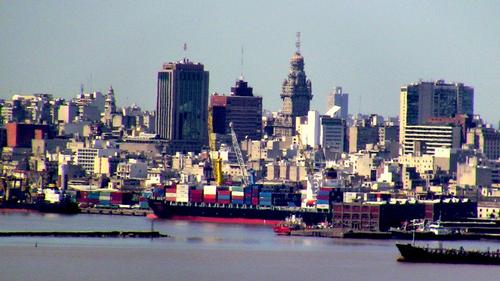 Montevideo seen from the HarborPhoto: Morrissey CC2.0 Generic mo changes made
Montevideo seen from the HarborPhoto: Morrissey CC2.0 Generic mo changes made
Montevideo is Uruguay's largest city, capital and main port. The settlement was founded in 1726 by Bruno Mauricio de Zabala. According to the 2011 census, Montevideo had a population of 1,319,108 (about half of Uruguay's population). The city is the center of trade and higher education in Uruguay: the first university, the Universidad de la República, was founded in 1849. The architecture of Montevideo, influenced by Spanish, Portuguese, Italian, French and British immigrants, reflects influences from colonial times up to the Art Deco period.
| advertisement |
| Hotels Montevideo |
Location
The coordinates of Montevideo are: 34°52'South latitude 56°10' West longitude.
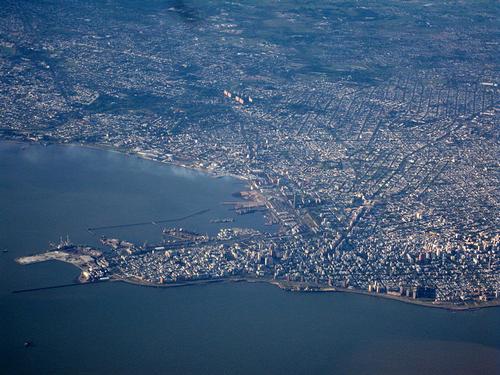 Bay of Montevideo from the airPhoto: Rabble CC 2.0 Generic no changes made
Bay of Montevideo from the airPhoto: Rabble CC 2.0 Generic no changes made
Montevideo is located on the northeastern bank of the Río de la Plata (the silver river in Spanish), which is 200 kilometers wide at the site. The river separates the southern coast of Uruguay from the northern coast of Argentina. The southern side of the city stretches along the coast lined with rocky outcrops and sandy beaches. Montevideo Bay is a natural harbor, the largest in Uruguay and one of the most beautiful natural harbors in the region. The city is located just a little further south than the Argentinian capital Buenos Aires. Montevideo covers an area of 530 square kilometers and stretches for 20 kilometers from west to east. The city is located at an average elevation of 43 meters.
Weather
Montevideo has a mildly humid subtropical climate with characteristics of a maritime climate: the winters are cool, the summers warm. Tropical cyclones do not occur, but thunderstorms are not rare. Due to its location in the southern hemisphere, the seasons are opposite to those in the northern hemisphere. Summer lasts from December to March, followed by autumn in April and May; winter lasts from June to September and spring is between October and November. The rainfall is regular and evenly distributed throughout the year, and is around 1,100 mm. The city has approximately 2,400 hours of sunshine per year.
In the summer, a moderate breeze blows from the sea, bringing fresh air into the overheated city in the evening. Montevideo has an annual average temperature of 16°C. The lowest recorded temperature is -5.6°C, while the highest is 42.8°C. Snowfall is extremely rare.
History
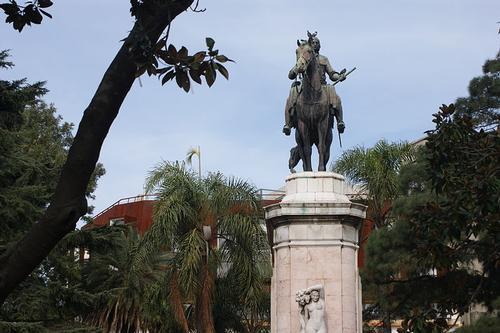 Statue of Bruno Mauricio de Zabala in MontevideoPhoto: Rosina Peixoto CCe 3.0 Unported no changes made
Statue of Bruno Mauricio de Zabala in MontevideoPhoto: Rosina Peixoto CCe 3.0 Unported no changes made
The City of Colonia de Sacramento was founded by the Portuguese in the vicinity of the bay, on the other side of Buenos Aires, between 1680 and 1683. In 1723 the Spanish started building fortifications on the heights around the bay of Montevideo. On January 22, 1724, the Spanish were exiled by the Portuguese led by Bruno Mauricio de Zabala and the city's growth began. The city was briefly under British rule in 1807.
Soon after its founding, Montevideo became the main city of the area north of the Río de la Plata and east of the Uruguay River. The city went on to compete with Buenos Aires for supremacy in the maritime trade.
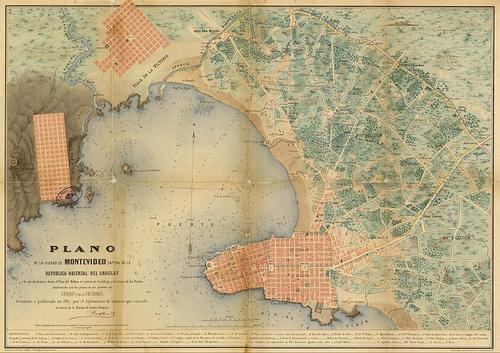 Map Montevideo from 1867Photo: Public Domain
Map Montevideo from 1867Photo: Public Domain
In the early 20th century, Montevideo experienced a boom in immigration from European countries, especially from Spain and Italy. In 1933, the Treaty of Montevideo was signed by nineteen countries in South America. Montevideo was involved in the first major naval battle in World War II: the Battle of the River Plate.
In the 1960s there was strong political repression, followed by violence until the end of the dictatorship in 1985. About a hundred people were killed during that period and there were many disappearances. In recent times, economic development and stronger commercial ties with neighboring countries have contributed to the city's well-being.
Sights
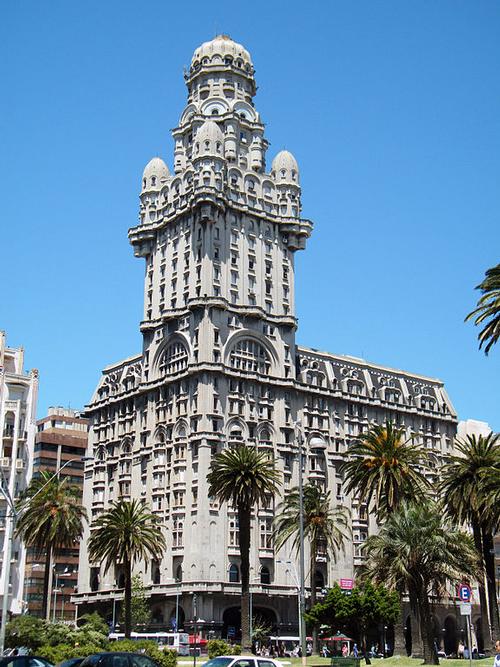 Palacio Salvo in MomtevideoPhoto: Coolcaesar CC 3.0 Unported no changes made
Palacio Salvo in MomtevideoPhoto: Coolcaesar CC 3.0 Unported no changes made
The architecture of Montevideo is varied. There are neoclassical buildings such as the cathedral, but also buildings in post-modern style such as the World Trade Center of Montevideo or the 158 meter high Antel Telecommunication Tower, the tallest skyscraper in the country. The Palacio Salvo, together with the Telecommunication Tower, dominates the skyline of the bay of Montevideo.
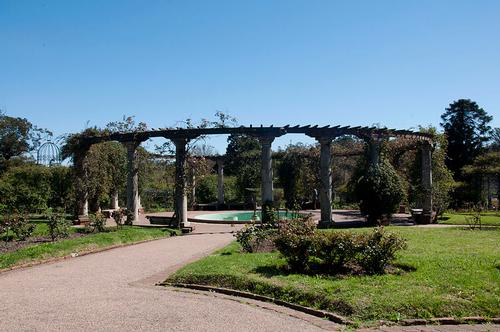 Parque Prado in MontevideoPhoto: Rarrillaga86 CC 3.0 Unported no changes made
Parque Prado in MontevideoPhoto: Rarrillaga86 CC 3.0 Unported no changes made
The old town shows the influence of the old European architecture. Notable government buildings are the Legislative Palace, the City Hall and the Estevez Palace. The most famous stadium is the Estadio Centenario. The Park of the Allies is a large public central park, located south of Avenida Italia and north of Avenida Rivera. Together with the Parque Prado and Parque Rodó, it is one of the three major parks in Montevideo. Created in 1873, Parque Prado is the largest of the city's public parks.
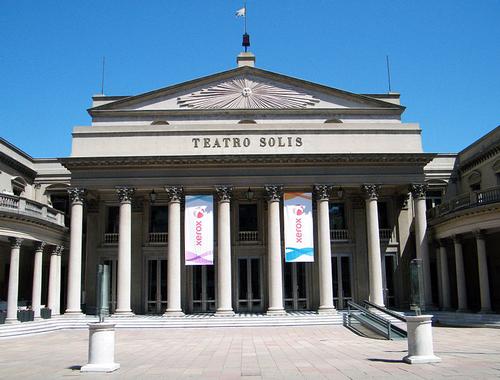 Solis Theater in MontevideoPhoto: Coolcaesar CC 3.0 Unported no changes made
Solis Theater in MontevideoPhoto: Coolcaesar CC 3.0 Unported no changes made
The main square of Montevideo is the Plaza Independencia, located between Ciudad Vieja and Montevideo old town. Built in 1856, the Solís Theater is Uruguay's oldest theater. Fortaleza del Cerro overlooks the bay of Montevideo. An observation post at this site was first built by the Spanish in the late 18th century.
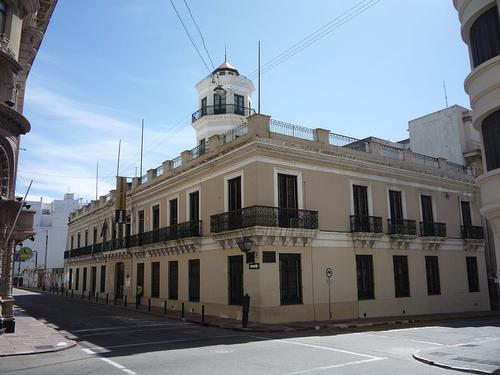 Nationa History Museum in MontevideoPhoto: Fulviusbsas in het publieke domein
Nationa History Museum in MontevideoPhoto: Fulviusbsas in het publieke domein
There are a number of interesting museums in Montevideo. The Decorative Arts Museum has an important collection of European paintings and decorative arts, ancient Greek and Roman art, and Islamic ceramics from the 10th to the 18th century from the area of present-day Iran. The National History Museum of Montevideo displays artifacts related to Uruguay's history. The National Museum of Natural History (1837) and the National Museum of Anthropology are also very attractive.
Tips
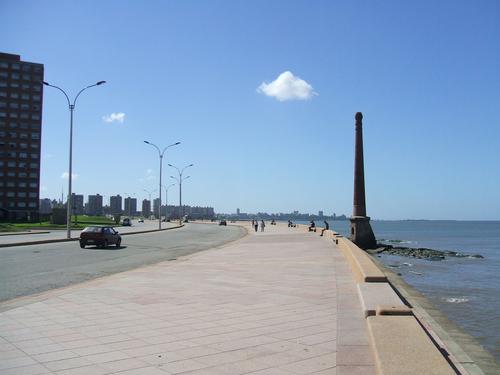 Ramblas of MontevideoPhoto: Todo tiempo pasado fue mejor CC 2.0 Generic no changes made
Ramblas of MontevideoPhoto: Todo tiempo pasado fue mejor CC 2.0 Generic no changes made
The Ramblas of Montevideo is a very large boulevard of more than 20 km long where you can walk or cycle given the distance. Especially in the evening with a beautiful sunset it is a good place to be. The Ramblas runs almost entirely along the coastline.
Useful links Montevideo
BBC Country ProfilesWorld Fact Book Explore all Countries
How to call
Last updated June 2025
Copyright: Team - The World of Info